Exhibition Highlights
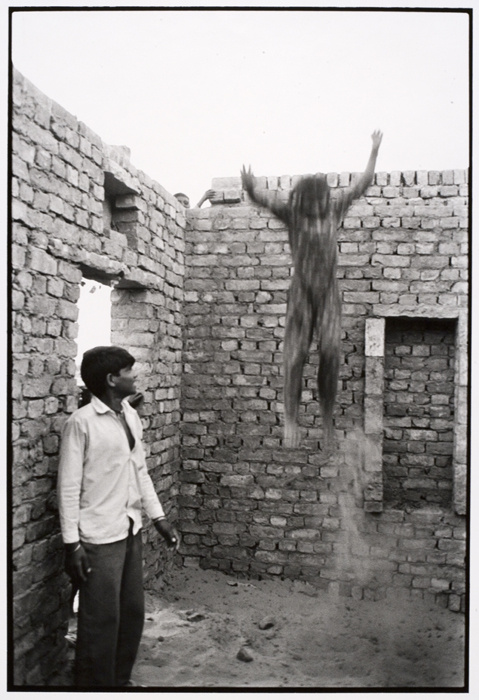
New homes after the flood, Lunkaransar, from the series "Notes from the Desert," 1999-2000
Gelatin silver print, 30 3/4 × 24 3/4 inches
Gift of Wanda Kownacki, the Lipman Family Foundation and Dipti and Rakesh Mathur
Gauri Gill
Born 1970, Chandigarh, India
Lives and works in Delhi, India
This photograph is part of a ten-year project in which Gauri Gill recorded the lived experiences of rural and migrant communities across the arid topography of Rajasthan in Western India’s border terrain. In such a harsh climate, instability is a given; time is marked by floods and droughts, epic cycles of birth and death. In this image, a figure leaps into the interior of an unfinished stone house. The blurred pattern of her clothing seems to melt into or emerge from the brick surface of the wall behind¸ intertwining figure and architecture.
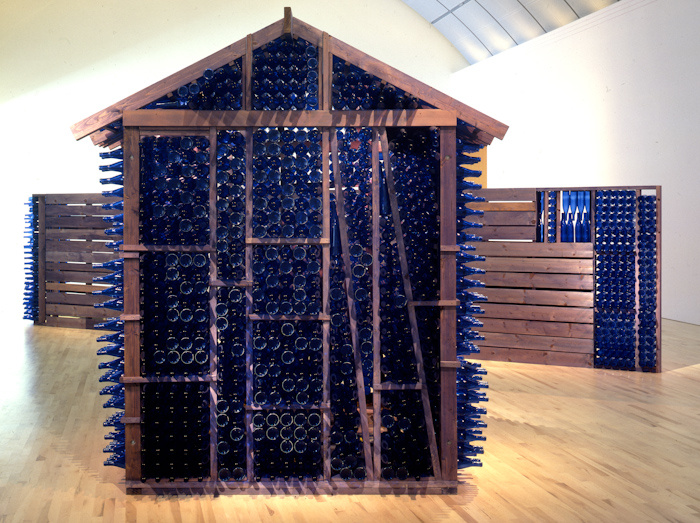
Adobe: Sanctuary for the Familia(r), 1994
Bottles, wood, sand, walking stones, and lights
Gift of Kate and Drew Gibson
Mildred Howard
Born 1945, San Francisco, California
Lives and works in Berkeley, California
Mildred Howard uses an everyday household item, a bottle, to construct a house where memories are treasured and relationships built. The title of the work intertwines the Spanish word for “family” with the English “familiar,” describing a sacred space in which inheritance is nurtured and protected in the very walls. Adobe: Sanctuary for the Familia(r) creates an environment for reflection and contemplation.
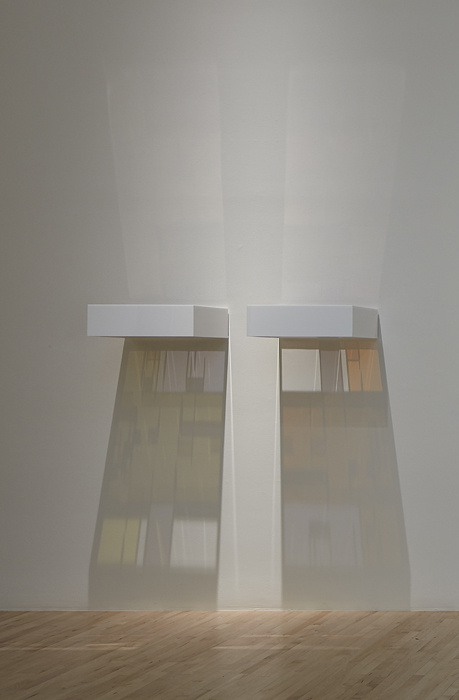
Kiss D7, 2015
Plexiglass and light, 7 1/4 × 59 × 17 inches
Museum purchase with funds provided by the Council of 100
Won Ju Lim
Born 1968, Gwangju, South Korea
Lives and works in Boston and Los Angeles
These boxlike sculptures offer a nod to minimalist artist Donald Judd, who made artwork with stacked geometric boxes, an industrial form which he felt carried no symbolic meaning. In Won Ju Lim’s hands, light cascades through the austere boxes, creating colorful, ethereal geometric shadows. The sculptural components within are plexiglass architectural models based on plans of the famed Case Study Houses—quintessential examples of midcentury modernism built in the Los Angeles area between 1948 and 1966. The house is a reference point for an idealized elsewhere, a logical, harmonious, and utopian existence. Lim examines the dialogue between real and imaginary space, as it relates to fantasy, memory, and longing.
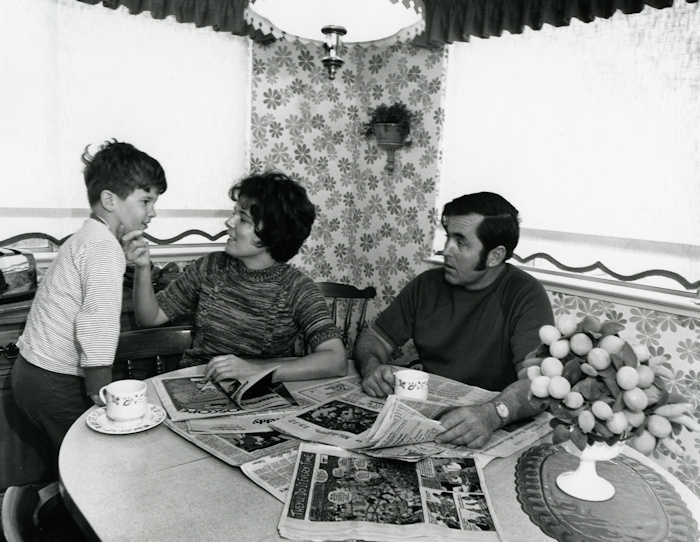
Sunday Breakfast Table, from the series "Our Kind of People," c. 1972-74
Vintage gelatin silver print, 8 × 10 inches
Gift of Robert Harshorn Shimshak and Marion Brenner
Bill Owens
Born 1938, San Jose, California
Lives and works in Hayward, California
Like a visual anthropologist, San Jose – born Bill Owens recorded the customs, social relationships, and domestic spaces that characterized the South Bay’s middle-class culture in the 1970s. While working as a photojournalist for the Independent, a local newspaper in Livermore, Owens used his weekends to document his surroundings as a true insider. His subjects were friends who invited him into their homes. Suburbia, the first in a series of four books Owens dedicated to the American dream, focuses on the East Bay suburbs. Our Kind of People followed in 1975, an examination of political, religious, scholastic, and sports groups.
Owens’s photographs record a generational phenomenon: the demographic and psychological shift of rapid migration of city apartment dwellers to newly produced suburban houses. For some, these photographs resonate with fond memories of San Jose’s past. Others, however, are reminded of the racially discriminatory housing policies and exclusionary tactics that mark the darker side of the American dream of homeownership.
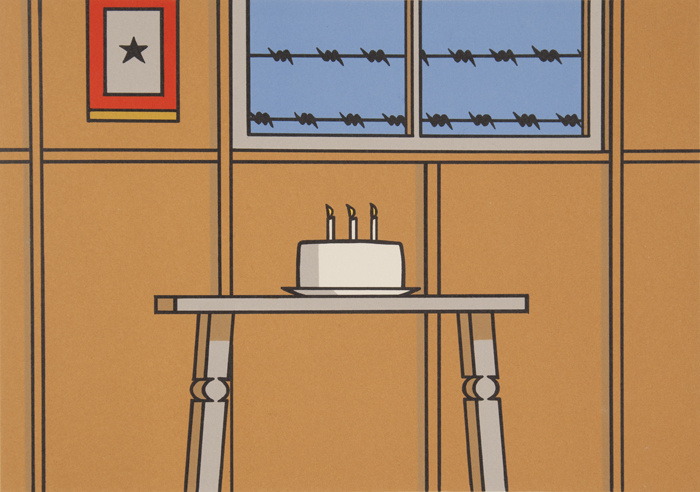
Memories of Childhood, 1999
Lithgraphs in handmade book, 7 × 10 inches
Gift of the artist
Roger Shimomura
Born 1939, Seattle, Washington
Lives and works in Lawrence, Kansas
For this series of prints, Roger Shimomura found inspiration in some of his earliest childhood memories: the two years during World War II that he and his family spent at the Minidoka War Relocation Center in Idaho. Like hundreds of thousands of people of Japanese ancestry around the United States, Shimomura and his family were forced to leave their homes and lives and reside in temporary shelters. These prints are filled with the artist’s memories of visits from friends, celebrating his birthday and Christmas, and ubiquitous barbed wire and wooden shacks—reminders of the freedom his family was denied.
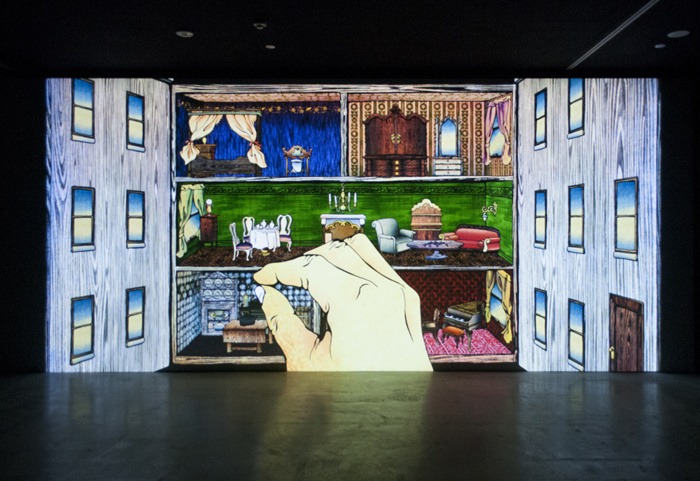
dolefullhouse, 2007
Single channel video installation with panoramic screen, 276 × 84 inches
Museum purchase with funds contributed by the Acquisitions Committee with additional funds provided by the Lipman Family Foundation
Tabiamo
Born 1975, Hyogo, Japan
Lives and works in Karuizawa, Japan
Tabaimo combines hand-drawn images that evoke traditional Japanese woodblock prints (ukiyo-e) with digital manipulation to offer a critical and complex view of contemporary Japanese society. In dolefullhouse, a doll house stands in for the Japanese body, which is invaded by bourgeois furnishings and octopus tentacles symbolizing Western culture. Disembodied hands systematically arrange rooms until invaded by the predatory cephalopod, triggering throbbing veins and a pulsing heartbeat. The hands grow restless, scratching themselves and the walls of the house, and upending its contents in the process. Eventually, a water leak turns into a flood, exposing the “guts” of the home—a heart, brain, and upper jaw—a metaphor for the complexities of maintaining Japanese identity in an increasingly global society.
Watch a video documentation of the artwork and interview with the artist by Art21
